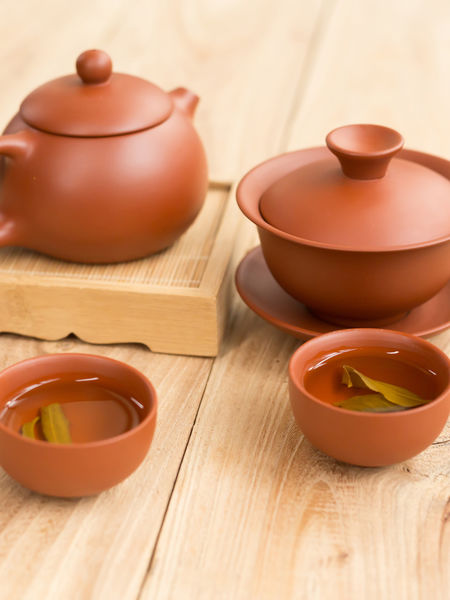The History of Chinese Teahouses


Today we're going to take a look at Chinese Teahouses as places where communities gather for news, entertainment, and tea!
Historians believe that tea houses first began in China during the Tang dynasty’s Kaiyuan era, era followed by the Song Dynasty when the entertainment element of a tea house was introduced with jugglers, poets, actors, opera singers, and storytellers.
STORYTELLING IN THE TEA HOUSE
One form of storytelling, held in Shuchaguan, tea rooms, were spoken “novels.” These stories were told in ways similar to the penny novels of 19th century England where a small printed chapter was issued each week which readers would eagerly await to buy, penny in hand. In the Chinese tradition, these “novels” were performed live by professional storytellers, often twice a day. Incorporating all the tools of enchantment: acting, singing, and speaking, they wove a story, revealing only a segment each day which enticed customers to return over and over to hear all the chapters that would make up the complete “novel” over several months’ time.
Another form of Chinese tea house storytelling, xiangsheng or crosstalk, originated in Tianjin, and is akin to modern-day stand-up comedy although rarely performed solo. Instead, two people engage in a comic dialogue spoken with the local dialect and imbued with news of the region to give a modern spin to classic tales.
A third form was dagu, done with a performer who would both sing and speak the story accompanied by percussion instruments, usually a small bass drum also called dagu, played with two sticks.
SOLVING DISPUTES, PLAYING CHESS, ENJOYING A VIEW
The Sichuan teahouses historically offered tea in distinctive red copper teapots to pour into gaiwan of fine Jingdezhen porcelain. The tea brewed was most likely the bowl-shaped compressed tea leaves, tuocha (primarily made of pu erh).
Unlike most teahouses which were for casual conversation or places for entertainment, the Sichuan tea house also served as unofficial courts where disgruntled parties would meet with an arbiter to discuss their conflicts. Tea would be served, the conflicts discussed, and, quite often, a resolution ensued. No trial, no juries, just one person to smooth over disagreements until they were abated while all three quaffed pots of tea. The two parties would formally offer apologies for engaging in a dispute, shake hands as a sign of agreement, pay for their tea and that of the arbiter, and depart in peace.
A SITE FOR BUSINESS, CHESS, VIEWING NATURE
For generations, and certainly in modern day, the tea house is the preferred place for the Chinese to conduct business. By surrounding oneself with style and grace, drinking an exceptional tea served unobtrusively, people could engage in their most serious business conversations discretely. The host could also share an awareness of fine teas by ordering the best the tea house had to offer, a gesture indicating deep respect for the guest and no small effort to close the deal.
Qichaguan, or chess tea rooms, invited customers to sit for hours, lean over painted wooden chess boards to intently play their games while they drank tea “to forget their sufferings.” These sessions were called wangyoujin or “Mr. Worry-free.”
The more artful tea rooms were Yechaguan, situated amid beautifully designed gardens that captured the changes reflected in each season. A version of these, Qing, featured dramatic pergolas built outside the gate of the teahouse. In this open space, under the sun, at least for every season but winter, the customers could socialize, take in the beauty of the lush landscape surrounding them, admire the architecture of the pergola, and drink tea.
DIM SUM AND THEN SOME!
In Guangdong, a delicious culinary twist was added to the tea house offerings: dim sum. Here one could eat morning or afternoon snacks of pork buns or steamed dumplings of shrimp and other treats both savory and sweet, along with pots of strong tea. This tradition is still hugely popular both in China and here in major U.S. cities with substantial Chinese populations like New York, San Francisco, and Los Angeles.
Waiters stroll the rooms pushing carts of hot dim sum served in covered metal trays or bamboo baskets which are placed, communal style, on the round tables where everyone can scoop up their favorites with chopsticks in hand. In Cantonese, this tea room experience is called yumcha, and is often part of weekend morning gatherings with entire families from toddlers to elders.
The Chinese tearoom of yore has retained its popularity as a safe place for groups of women to gather unaccompanied by guardians or spouses, or for a single person to stop for a cup of tea on a work or shopping break, and as a place for elders, especially men, to smoke, drink tea, and show off their prized birds, usually singing finches in bamboo cages.
TEAS, DÉCOR & MORE
The teas served in China’s tea houses were usually those grown in the region where the tea house was. So one would drink Longjing or Dragonwell in the West Lake area; oolongs in Fujian, or for the elders everywhere, white teas. The covered cup, the gaiwan, was a convenient way to serve tea, consolidating teapot and cup in one. Some regions used copper teapots, others use porcelain ones, and most often, the small, handle-less cups were made of porcelain, from the most delicate to the most functional and roughly sturdy, reflecting the wealth or modesty of the people in the area. Most of these tea choices and accoutrements are still used in modern-day tea houses.
Ambiance meant less than the idea that the venue was open and available to all to have a cup of tea and spend a few minutes of calm away from the demands of work or home. Décor could be modest, from small calligraphy scrolls and simple wood furniture to elaborately carved, highly-polished rosewood furniture, artful lanterns hung from the ceilings or colorfully embroidered silk fabric on the walls.
The one thread through all these centuries of tea houses has been the focus on being a venue for the community to come together over a cup of tea. The entertainment, conversations, locale, and décor were never formalized or governed by protocol or ritual. Instead, they were, and are, natural outgrowths of what happens when people gather to share the news of the day, tell traditional stories, and play songs in the sanctuary where one “forgets one’s sufferings” with tea.
